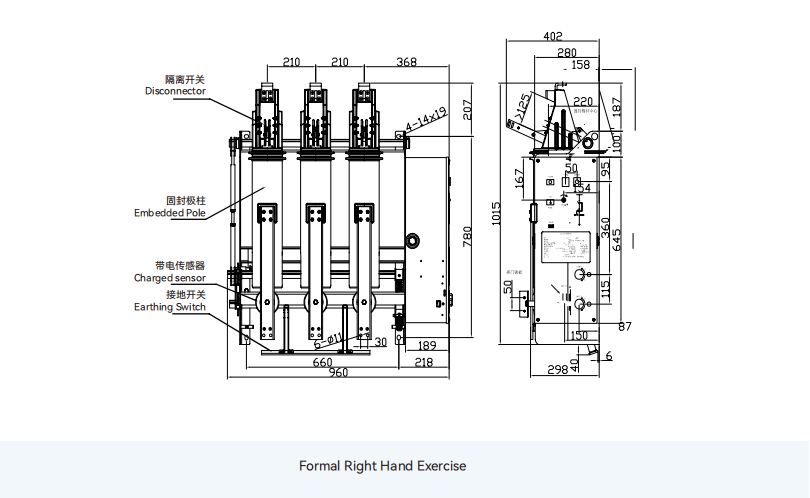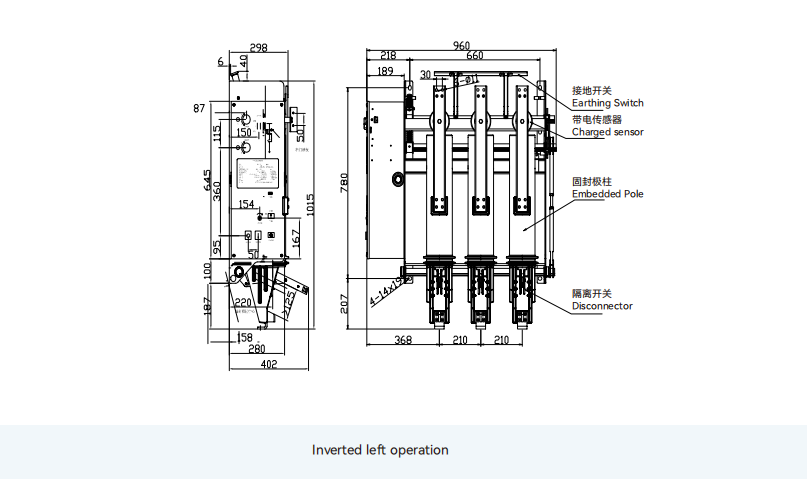YKD-12GD indoor high-voltage three station vacuum Circuit Breaker has excellent electrical and mechanical peformance,reliable and stable mechanism, and long seⅣice life. me main circuit adopts fixed sealed Pole, which improves the environmental adaptability and Insulation reliability of the circuit breaker; Reliable mechanical and electronic peformance, extended mechanical and electronic lifespan,make maintenance free circuit breakers possible. It can be used in 3.6-12kV power systems as a power grid equipment and a protection and control unit
for power design in industrial and mining enterprises. It is suitable for various types of loads and frequent operations, as well as situations where short-circuit currents are disconnected multiple times. me product has complete mechanical and electrical interlocking devices with extremely high operational stability and reliability, ensuring the safety of operators and equipment, and ensuring electrical safety.
1.Model and meaning

2.Main technical parameters
| Project | Unit | Parameter |
| Rated voltage | kV | 12 |
| Rated frequency | Hz | 50 |
| Rated current | A | 630 | 1250 |
| Lightning impulse withstand voltage | kV | Ground and phase 42, isolation port 48 |
| 1-minute power frequency withstand voltage | kV | Ground and phase 75, isolation port 85 |
| Rated peak withstand current | kA | 25 | 31.5 |
| 4S rated short-time withstand current | kA | 25 | 31.5 |
| Rated short-time withstand current duration | s | 4 |
| Rated short-circuit current breaking times | Once | 30 |
| Rated short-circuit closing current | kA | 63 | 80 |
| Contact opening distance | mm | 9±1 |
| Trip | mm | 3.5±1 |
| Contact closing bounce time | ms | ≤2 |
| Three phase asynchronous opening and closing | ms | ≤2 |
| Opening time | ms | ≤40 |
| Closing time | ms | ≤60 |
| Rated sho-circuit breaking current |
| 25 | 31.5 |
| Mechanical lifespan (isolating switch/circuit breaker/grounding switch) | Once | 3000/10000/3000 |
| Rated operating sequence |
| Min-0.3s HeFen-180s HeFen |
3.Appearance and installation dimensions


Working principle of circuit breaker
A circuit breaker is an essential electrical safety device used to protect an electrical circuit from damage caused by overload or short circuit. It automatically interrupts the flow of electricity when a fault is detected, preventing damage to appliances, wiring, and electrical components.
Basic Function
The primary function of a circuit breaker is to interrupt the flow of electricity in the event of an overload or short circuit. The circuit breaker senses these abnormal conditions and opens the electrical circuit to stop the current, thus preventing further damage. Once the fault is cleared, the circuit breaker can be manually or automatically reset to restore the flow of electricity.
Types of Circuit Breakers
Circuit breakers come in different types, including:
Thermal Circuit Breakers: These use a bimetallic strip that bends when it heats up due to excess current. The bending of the strip causes the breaker to trip, interrupting the current.
Magnetic Circuit Breakers: These use an electromagnet to trip the breaker when the current exceeds a preset limit. The magnetic field generated by the excessive current pulls the contact apart, cutting off the flow of electricity.
Thermomagnetic Circuit Breakers: These combine both thermal and magnetic elements, offering a more comprehensive protection system. They can detect both overloads (using thermal protection) and short circuits (using magnetic protection).
Residual Current Circuit Breakers (RCCB): These detect leakage currents that may occur due to faults in the electrical system. RCCBs help in preventing electrocution by immediately cutting off power when leakage is detected.
Working Mechanism
Overload Protection: When a circuit is overloaded, the excessive current heats up the bimetallic strip (in thermal breakers) or energizes the electromagnet (in magnetic breakers). This heating or magnetization causes the mechanism to trip, breaking the circuit.
Short Circuit Protection: A short circuit occurs when the current bypasses the normal load, usually due to a fault. In magnetic circuit breakers, the rapid increase in current creates a strong magnetic field, which quickly trips the breaker. Thermal breakers might be slower in detecting this, but once the circuit is overloaded, they will trip after a delay.
Resetting: After the circuit breaker trips, it must be manually reset. Some circuit breakers are designed to reset automatically after the fault is cleared, ensuring continuous protection without manual intervention.
Importance of Circuit Breakers
Protection: The main purpose of a circuit breaker is to safeguard electrical systems and prevent fires, equipment damage, and electrical shock hazards.
Efficiency: By detecting faults in the circuit quickly, circuit breakers help in reducing system downtime and maintaining operational continuity.
Compliance: Circuit breakers are crucial for meeting safety standards and electrical regulations in residential, commercial, and industrial settings.
Applications
Residential: In homes, circuit breakers protect household appliances and wiring from electrical faults. They are usually located in the main electrical panel.
Industrial: In industrial setups, circuit breakers are used to protect heavy machinery, control panels, and other equipment from overloads and short circuits.
Commercial: Circuit breakers in commercial buildings ensure that electrical systems remain operational and protected from faults.
Conclusion
Circuit breakers play a critical role in ensuring the safety and longevity of electrical systems. They are designed to detect and interrupt dangerous electrical faults, preventing costly damage and hazards. By understanding their types and how they work, we can appreciate their importance in safeguarding our homes, businesses, and industries.




 RELATED
RELATED

Comment
(0)